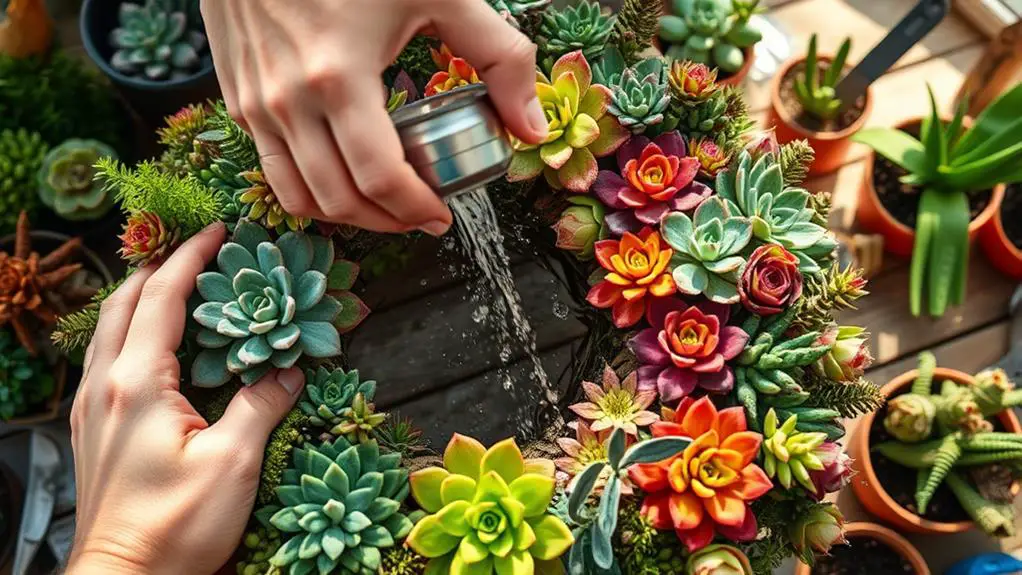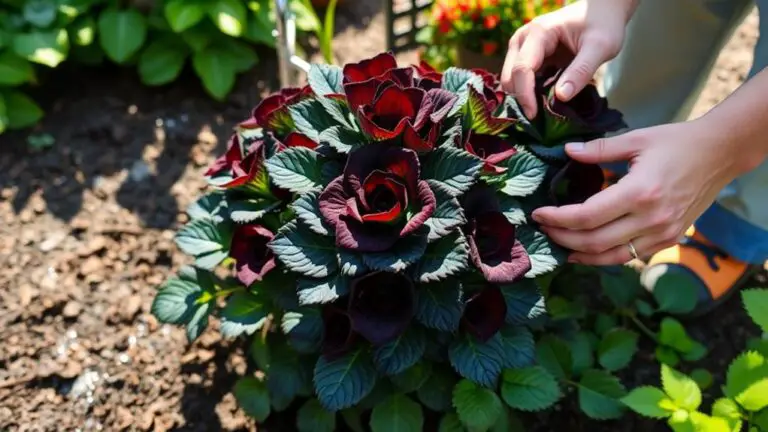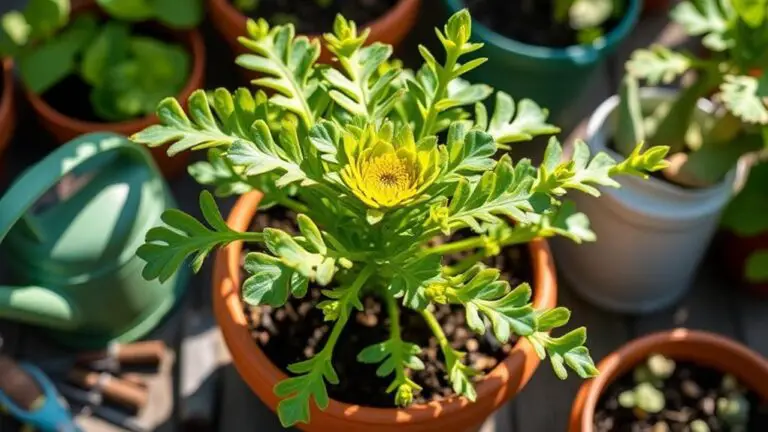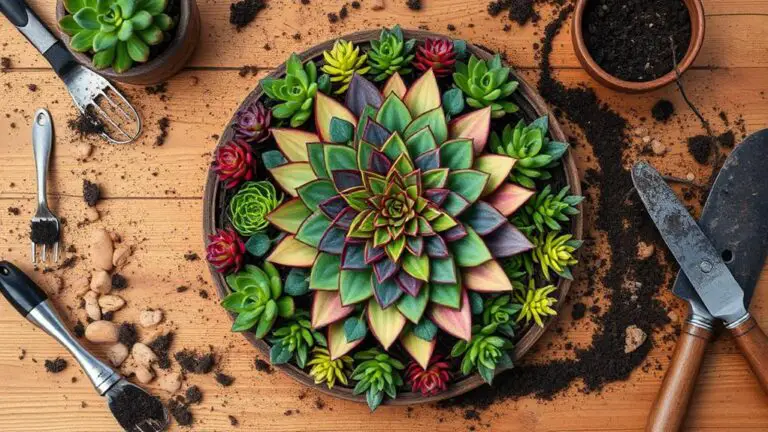9 Essential Tips to Maintain Your Succulent Wreath
Maintaining your succulent wreath might seem straightforward, but there are key factors you need to reflect on to keep it vibrant and healthy. By choosing the right placement and gathering necessary materials, you set the foundation for success. Preparing your cuttings and assembling the wreath correctly also play fundamental roles. But what about controlling light exposure and mastering watering techniques? These steps are critical and often overlooked. And don't forget about fertilizing, seasonal care, and pest monitoring. Each tip has its nuances, and understanding them can make all the difference. Curious about these essential tips? Let's explore each one in detail.
Choose the Right Placement
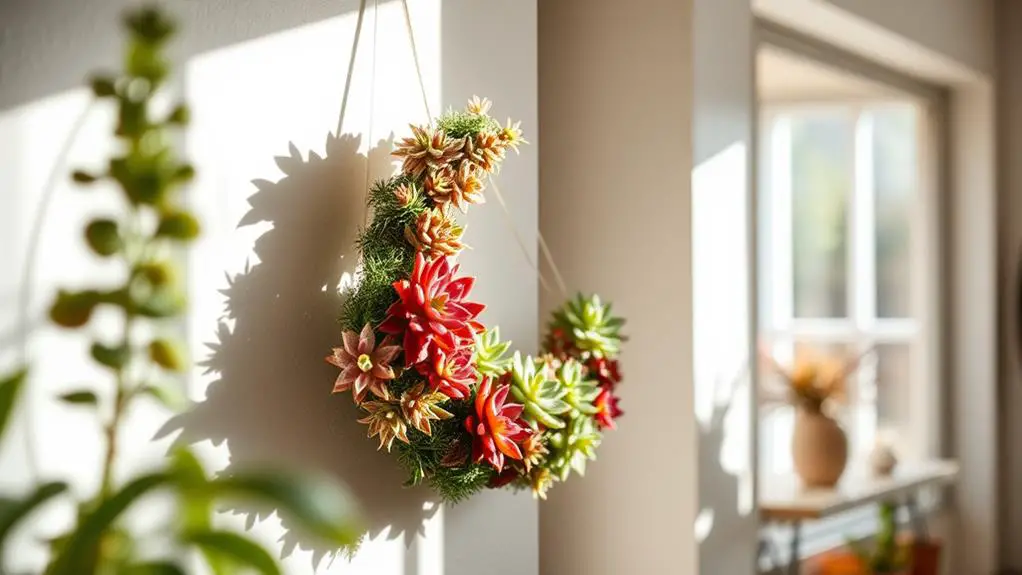
Choosing the right placement is essential for your succulent wreath's health and longevity. To keep your wreath thriving, you need to find a spot that gets bright, indirect light. This helps your succulents grow well without stretching.
Avoid placing the wreath in direct sunlight, especially in the afternoon, as it can scorch the plants. Instead, let it soak up some morning sun every few days for the best results.
When hanging your wreath, make sure to use sturdy hooks or nails. These should ideally be attached to wall studs since a dry wreath can weigh between 2-8 pounds and can double in weight when wet.
If the hanging spot isn't strong enough, your wreath could fall and get damaged.
Consider hanging the wreath in a covered area. This will protect it from strong winds and heavy rain, which can harm the succulents.
You also have some decorating flexibility: you can hang your wreath like a mirror or lean it against a wall. This allows you to get creative with your space while ensuring your succulent wreath stays healthy and beautiful.
Gather Necessary Materials
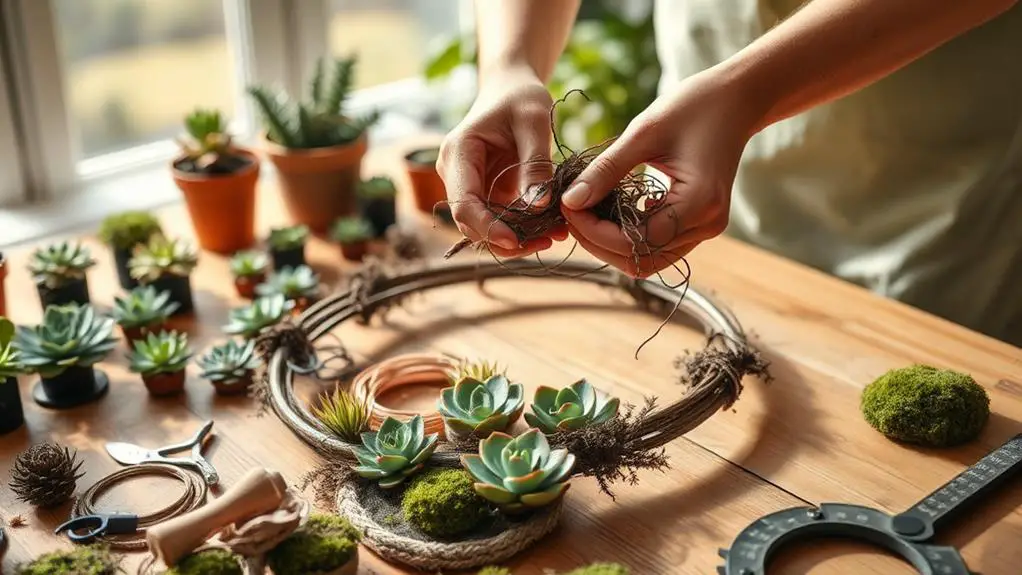
To start your succulent wreath, you'll need 75 to 100 succulent cuttings, so gather a mix like sedum, aeonium, and echeveria for a vibrant look.
Make sure you have scissors to trim the cuttings, a 14-inch mesh-covered moss wreath form as your base, and U-shaped floral pins to keep everything in place.
Don't forget that letting your cuttings dry overnight can help prevent rot when you assemble your wreath.
Essential Tools Required
Creating a stunning succulent wreath starts with gathering the right materials. Start by knowing exactly what you need to make the process smooth and enjoyable.
- Succulent Cuttings: You'll need between 75 to 100 succulent cuttings. Choose a variety like sedum, aeonium, echeveria, kalanchoe, and jade. This mix guarantees a vibrant and diverse aesthetic.
- Wreath Form: A 14-inch mesh-covered moss wreath form serves as the foundation. It provides the necessary support and environment for your succulents to thrive. The mesh helps hold everything together, while the moss retains moisture.
- Floral Pins: U-shaped floral pins are vital for securing your succulent cuttings. They keep the plants in place as they establish roots, making sure your wreath remains intact and beautiful.
- Scissors: These are important for trimming your cuttings, particularly to remove lower leaves. Clean cuts help prepare the stems for planting and promote healthy growth.
Optional but recommended: use a tray for drying your cuttings overnight. This step helps prevent rotting by allowing the cut ends to callus before assembly.
Sourcing Succulent Cuttings
When it comes to sourcing succulent cuttings, the quality of your materials can make or break your wreath. Start by choosing high-quality succulent cuttings from reputable suppliers like Petal Driven. They guarantee your cuttings arrive in excellent condition and need minimal care upon unpacking.
Aim to gather about 75-100 cuttings to create a full and lush wreath. Popular varieties include sedum, aeonium, echeveria, kalanchoe, and jade.
Once you have your cuttings, prepare them by removing the lower succulent leaves. This step helps the cuttings root better. Let the cuttings dry and callus overnight to prevent rotting.
Before planting, cuttings should be rinsed under cool water to remove any dirt or pests. Then, let them dry in the shade to avoid excess moisture, which can harm the plants.
To add variety and save money, consider purchasing cuttings in different sizes. For example, 5cm and 9cm Echeveria can create a visually diverse wreath without breaking the bank.
Prepare Your Cuttings
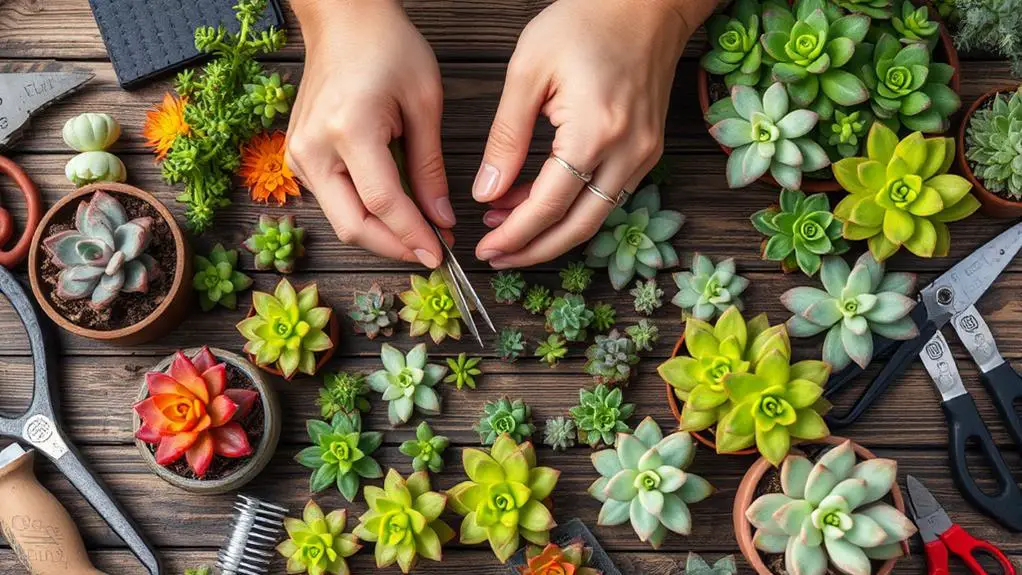
To prepare your cuttings, start by trimming them to leave about a one-inch stem and removing the lower leaves to help with rooting.
Let the cuttings dry and callus overnight on a tray; this step is essential to prevent rot and promote healthy roots.
Choose hardy varieties like sedum, aeonium, echeveria, kalanchoe, and jade for the best results, and make sure you have 75 to 100 cuttings for a beautiful, full wreath.
Trim Lower Leaves
Start by removing the lower leaves from your succulent cuttings, leaving about a one-inch stem to help them root more effectively. This simple step is essential for guaranteeing that your succulent wreath not only looks tidy but also thrives.
When you trim the lower leaves, you're preparing the cuttings properly for rooting, which is vital for their long-term health and growth.
Choosing hardy varieties like sedum, aeonium, echeveria, kalanchoe, and jade will enhance both the growth and aesthetic appeal of your wreath.
To help you get started, follow these key steps:
- Select Healthy Cuttings: Pick cuttings from robust, well-established plants to guarantee they're strong enough to root and grow.
- Trim Lower Leaves: Carefully remove the lower leaves, leaving about a one-inch stem. This helps the cuttings root more effectively and gives your wreath a polished look.
- Place on a Tray: Arrange the trimmed cuttings on a tray to prepare them for drying overnight. This step helps prevent rotting by allowing the cuttings to callus.
- Inspect for Damage: Check your cuttings for any signs of damage or disease to guarantee only the healthiest parts are included in your wreath.
Dry Overnight
Preparing your succulent cuttings for a succulent wreath is an important step that shouldn't be overlooked.
To start, trim your succulent cuttings so that they've about a one-inch stem. This will help them fit nicely into your wreath. Next, remove any lower leaves to guarantee the stem can be inserted properly later.
Once you've prepared the cuttings, place them on a tray and let them dry out completely. It's vital to make certain they dry and callus overnight, which will help prevent rotting when they're placed in the wreath. The callus acts as a protective barrier, promoting healthier growth.
During this drying process, keep the succulents in a shaded area. Direct sunlight can damage the cuttings and hinder their ability to callus properly. An indirect light spot indoors or in a shaded outdoor area will work best.
Select Hardy Varieties**
Choosing the right succulent varieties is vital for creating a resilient and visually appealing wreath. Opting for hardy succulent varieties like sedum, aeonium, echeveria, kalanchoe, and jade guarantees your wreath remains robust and stunning.
These types aren't only resilient but also adapt well to wreath arrangements.
When preparing your cuttings, follow these steps to make certain they're ready for rooting and healthy growth:
- Remove Lower Leaves: Carefully strip the lower leaves from each cutting, leaving about one inch of the stem exposed. This step is fundamental for better rooting.
- Allow to Callus: Place your cuttings on a tray and let them dry and callus overnight. This prevents rotting once they're inserted into the wreath.
- Healthy Cuttings: Before assembly, inspect each cutting to confirm it's healthy and free of pests. Healthy cuttings will promote successful growth and longevity for your wreath.
- Quantity Matters: Aim for a total of 75 to 100 cuttings. This number will give your wreath a lush and dense appearance, making it look full and vibrant.
Assemble the Wreath
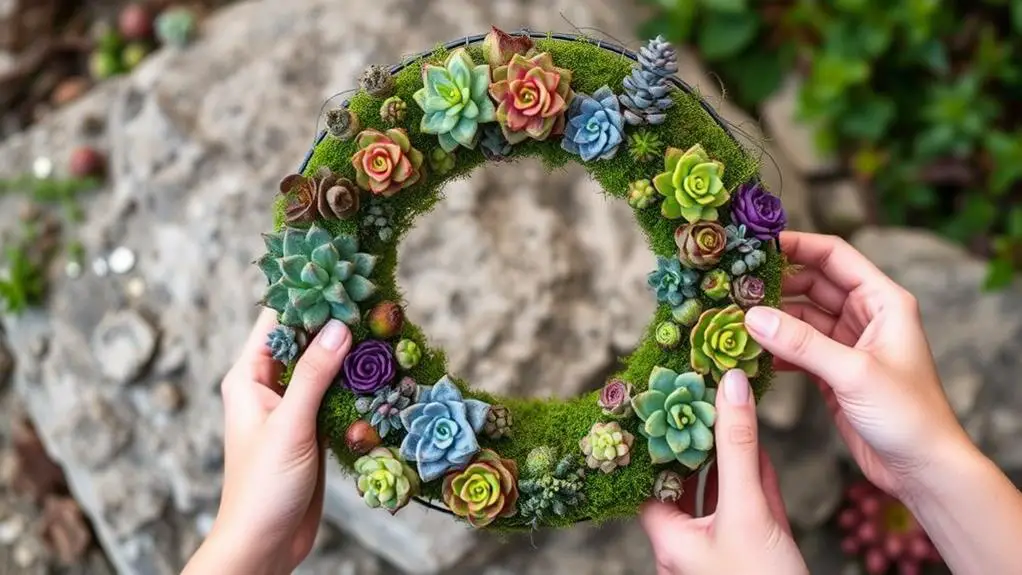
To assemble your succulent wreath, begin by thoroughly soaking the 14-inch mesh-covered moss wreath form in water for a couple of hours, ensuring the moss is completely saturated. This step is essential for creating a healthy base for your succulents.
Next, prepare 75 to 100 succulent cuttings by trimming the lower leaves and leaving a one-inch stem. Let these cuttings dry and callus overnight. This helps prevent rotting when you insert them into the moss.
Take your fully soaked wreath form and create small holes in the moss for each succulent stem. Insert the cuttings gently to maintain the integrity of the leaves. Start with the larger succulents to establish a solid base, then fill in with smaller cuttings for a dense and full appearance. Use U-shaped floral pins to secure the cuttings in place, ensuring they stay put as the wreath establishes itself.
Here's a quick guide to help you:
| Step | Tools Needed | Tips |
|---|---|---|
| 1 | Wreath form | Soak thoroughly |
| 2 | Succulent cuttings | Trim and let dry |
| 3 | Small tool | Create holes in moss |
| 4 | Floral pins | Secure cuttings |
Control Light Exposure
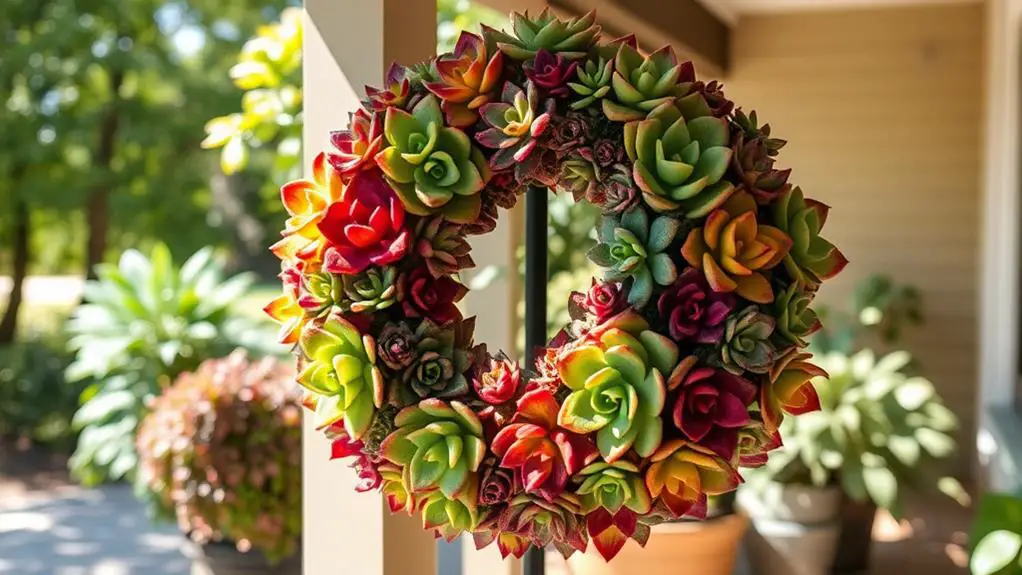
Making certain your succulent wreath thrives starts with controlling its light exposure. Succulents love bright, indirect light, making a spot near a window perfect. However, don't let them sit in direct afternoon sun, as it can burn their leaves. Morning sun is fine, but you should limit how long your wreath stays in it to protect it from strong winds and heavy rain.
Here are four key tips to help manage light exposure for your succulent wreath:
- North-Facing Doors: These provide the best light conditions for your wreath. They offer enough light without exposing the succulents to harsh sunlight.
- Covered Areas: Placing your wreath in areas with limited direct sunlight helps regulate light exposure. This prevents your succulents from stretching and growing leggy due to inadequate light.
- Use Grow Lights: During winter, natural light mightn't be enough. Grow lights can enhance light conditions, keeping your succulents healthy and preventing them from becoming leggy.
- Rotate Regularly: By rotating your wreath every few days, you make certain all parts receive equal light. This promotes even growth and keeps your wreath looking lush and vibrant.
Watering Techniques
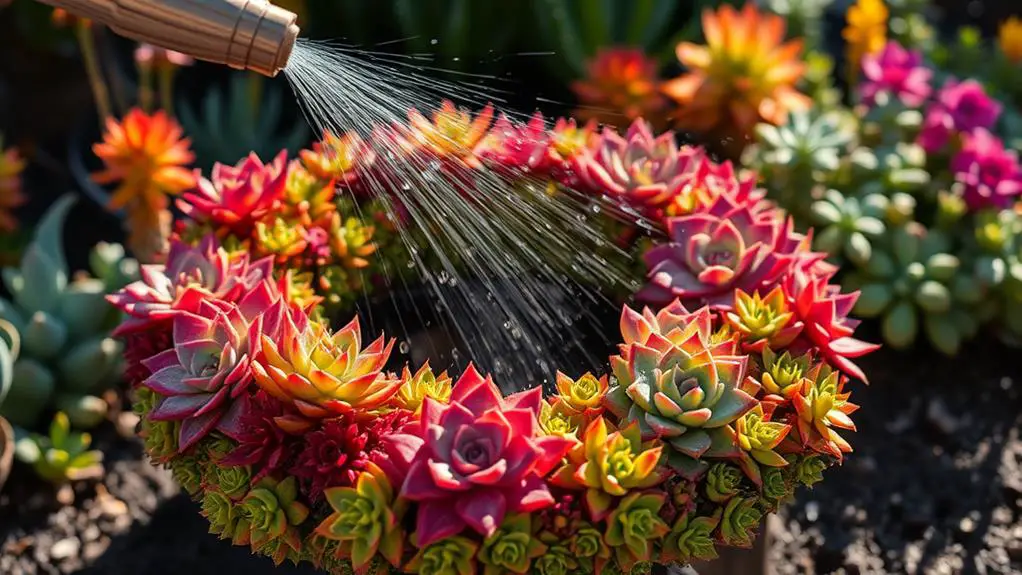
Watering your succulent wreath correctly is vital for its health and longevity. Start by soaking your wreath in room temperature water for about 5 minutes. This allows the moss to absorb the necessary moisture without over-soaking.
Make certain to let the wreath drain properly afterward to prevent root rot. Succulents need well-aerated environments to thrive, so good drainage is essential.
Monitoring the moisture level of your wreath is also important. Typically, indoor wreaths need watering every 2-3 weeks. However, you might need to adjust this schedule based on your local climate and humidity.
Keep an eye out for visual cues like wrinkled or shriveled leaves, which indicate that it's time to water your wreath.
Avoid frequent showers, as they can't saturate the moss as effectively. Instead, soaking techniques guarantee that the moss and succulents get the moisture they need while preserving the integrity of the plant cuttings.
Remember to place your wreath in indirect light to prevent the succulents from becoming too stressed.
Fertilizing Your Wreath

While proper watering keeps your succulent wreath hydrated, providing the right nutrients is equally important for its overall health. To guarantee your wreath thrives, you should fertilize it annually, with spring being the best time for feeding. This is essential because the limited soil volume in a wreath can quickly become depleted of essential nutrients.
Using an organic liquid fertilizer like sea kelp or fish emulsion is ideal for promoting healthy growth. These types of fertilizers provide a balanced mix of nutrients that succulents need.
Here are some tips to help you:
- Apply evenly: Spread the fertilizer across the entire wreath to guarantee balanced root nourishment. This prevents any one area from getting too much, which could harm the plants.
- Optional late summer feeding: If your succulents thrive in warmer months, consider a second feeding in late summer to boost growth.
- Monitor health: Keep an eye on your succulents. If they seem lackluster, you might need to adjust the fertilization frequency.
- Use organic options: Organic fertilizers are gentler on your plants and the environment, helping your wreath stay vibrant without harsh chemicals.
Seasonal Care Tips
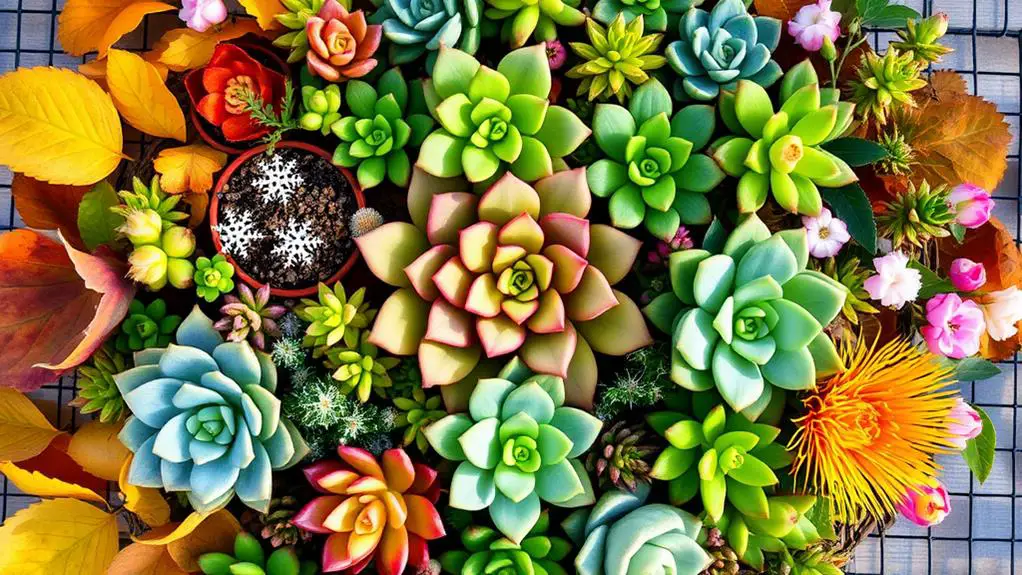
Adapting your succulent wreath care to seasonal changes is vital for maintaining its vigor throughout the year.
During winter, it's important to know which succulents in your wreath are cold-hardy. Cold-hardy succulents can stay outside, but if you have non-frost tolerant varieties, bring them indoors to a warm, sunny room. This prevents cold damage and keeps your wreath healthy.
Watering needs change with the seasons too. In winter, reduce the frequency to about every two weeks since growth slows down. Always check the soil before watering to avoid overwatering.
Your local climate greatly impacts how you care for your succulent wreaths. If you live in a warmer area, your outdoor succulent might need more water and shade. In colder regions, make sure your wreath gets enough light.
Regular maintenance is key. Trim overgrown succulents to keep the wreath looking neat and healthy.
Remove any dead leaves to prevent rot and pests. Adding new cuttings can refresh the design and keep it vibrant throughout the year.
Monitor for Pests
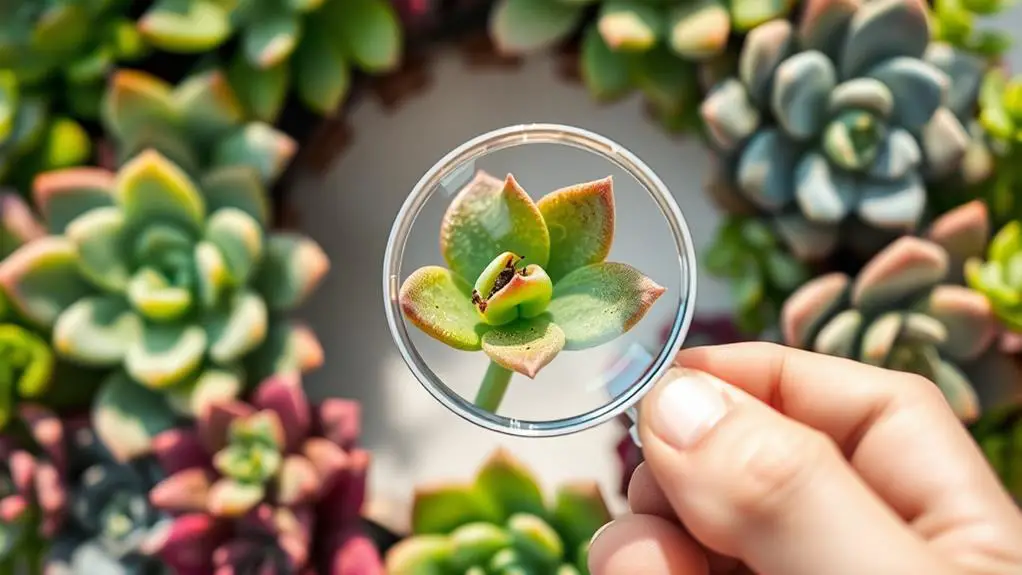
Keeping a vigilant eye on your succulent wreath for pests is vital in guaranteeing its health and longevity. Regularly inspect your wreath for common pests like mealybugs and aphids, which can cause significant damage if left untreated.
Healthy succulents are generally more resistant to pests, so maintaining their overall health through proper care is essential.
To help you stay on top of pest management, follow these steps:
- Inspect Regularly: Check your wreath at least once a week for signs of pests or damage. Look for discolored or wilting leaves, which could indicate an infestation.
- Remove Pests Gently: If you spot any pests, remove them carefully by spraying the affected areas with water or using a diluted alcohol solution. This helps eliminate the infestation without harming your plants.
- Maintain Plant Health: Keep your succulents healthy by providing adequate light, water, and nutrients. Healthy plants are more resistant to pests and less likely to suffer damage.
- Monitor After Treatment: After treating for pests, continue to check your wreath regularly to guarantee no pests remain. This will help prevent future outbreaks and keep your wreath looking its best.
Frequently Asked Questions
How to Keep a Succulent Wreath Alive?
To keep a succulent wreath alive, water it every 3 to 6 weeks, give it bright, indirect light, lay it flat initially, fertilize annually, and remove dead leaves and pests regularly. Follow these steps for a thriving wreath.
How Often Should I Water a Succulent Wreath?
You should water your succulent wreath every 1 to 3 weeks, depending on your climate. In dry conditions, aim for 1-2 times a week, while in humid areas, every other week is sufficient. Let the moss dry completely.
How Do You Maintain a Succulent Arrangement?
You'll need to water it every 1-3 weeks, guarantee bright indirect light, remove dead leaves, fertilize annually in spring, and monitor for dehydration. Adjust watering based on climate to keep succulents healthy and thriving.
How Do You Take Care of a Living Wreath?
You should lay your living wreath flat for 1-2 months, water it thoroughly every 1-3 weeks, gradually increase light exposure, fertilize in spring and summer, and prune dead leaves regularly to keep it healthy.
Conclusion
You've got all the tools and tips you need to keep your succulent wreath thriving. Just remember to place it in the right light, water it carefully, and give it some love with annual fertilization. Keep an eye out for pests and trim as needed. With a little attention and care, your wreath will stay beautiful and healthy all year round. Happy gardening, and enjoy the process! You've totally got this.

